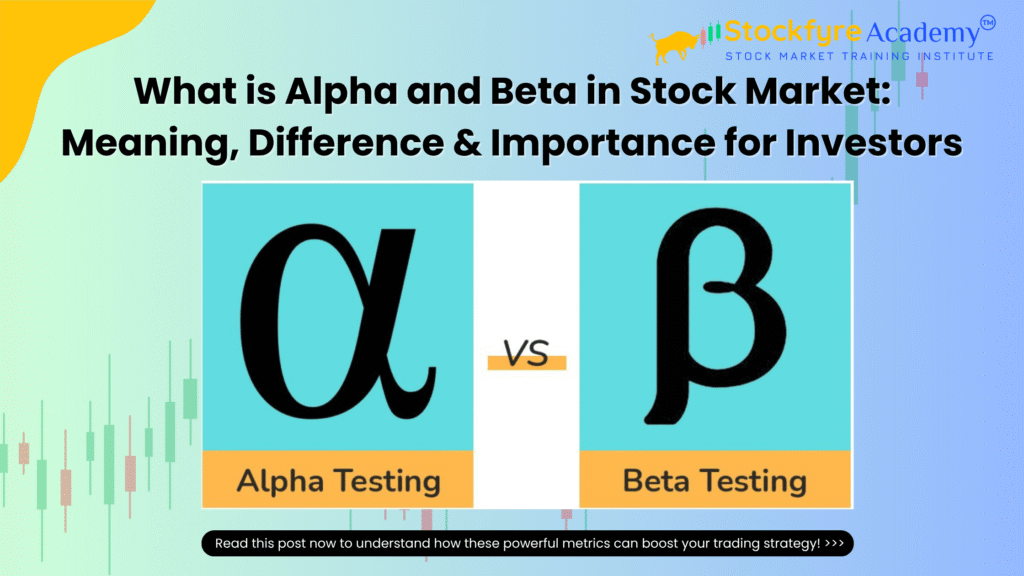Why Every Trader Should Know About Alpha & Beta
If you’re diving into the stock market — whether as a beginner or seasoned trader — two terms you must understand are Alpha and Beta. These are not just technical jargon; they are essential risk and performance indicators for investors. Whether you’re searching for the best stock market institute near me, or looking to enhance your understanding of financial concepts, this guide will make Alpha and Beta crystal clear.
At Stockfyre Academy — one of the top 10 stock market training institutes in Lucknow — we train aspiring traders to understand these metrics deeply, and how they apply to real-world investing.
- What is Alpha in the Stock Market?
Alpha measures a stock or portfolio’s performance relative to a market index (like the Nifty 50). In simple terms, it tells you how much better or worse your investment performed compared to the market.
- Positive Alpha = Investment outperformed the market
- Negative Alpha = Investment underperformed the market
➕ Positive Alpha
- Means the stock outperformed the market.
- Example: If Nifty gave 10% returns, and your stock gave 15%, the Alpha is +5.
➖ Negative Alpha
- Means the stock underperformed the market.
- If your stock returned 8% when Nifty gave 12%, the Alpha is -4.
Alpha = (Actual Return) – (Expected Market Return)
Use: Investors look for positive alpha stocks to beat the market consistently.
Example: If a mutual fund returns 12% and the market returns 10%, the fund’s Alpha is +2% — meaning it generated extra return.
2. What is Beta in the Stock Market?
Beta measures the volatility or risk of a stock compared to the overall market. It tells you how much a stock’s price moves when the market moves.
- Beta = 1: Moves with the market
- Beta > 1: More volatile than the market
- Beta < 1: Less volatile than the market
Beta Values:
Beta | What It Means |
1 | Moves same as market |
>1 | More volatile than market |
<1 | Less volatile than market |
<0 | Moves opposite to market (rare) |
Example:
If a stock has a Beta of 1.5, it is 50% more volatile than the market. High Beta stocks can offer bigger gains — or bigger losses.
- Beta = 1.5 → If Nifty moves +1%, stock may move +1.5%.
- Beta = 0.8 → If Nifty moves +1%, stock may move +0.8%.
Use: High beta = good for swing/intraday traders.
Low beta = safer for long-term investors.
3. Alpha vs. Beta: The Key Differences
Feature | Alpha | Beta |
Definition | Excess return over benchmark | Risk compared to the market |
Indicates | Skill of fund manager or strategy | Stock’s volatility |
Goal | Higher is better | Depends on risk appetite |
Ideal For | Evaluating performance | Measuring risk tolerance |
Why Alpha and Beta Matter to Investors
Understanding Alpha and Beta helps you:
- Evaluate fund manager performance
- Choose between aggressive vs. conservative investments
- Balance your risk and return expectations
- Select stocks or mutual funds smartly based on your financial goals
Summary Table:
Term | Meaning | Ideal For | Risk |
Alpha | Measures performance vs market | Long-term investors | Low |
Beta | Measures volatility vs market | Traders & risk analyzers | Varies |
Real-Life Analogy:
- Alpha = Your car reached faster than Google Maps predicted → Great driving (Performance)!
- Beta = How much your car wobbles on the road when the road (market) is bumpy → Risk!
At Stockfyre Academy, we teach how to apply these ratios to real trades and investments, so you not only understand the market but also beat it.
Learn These Concepts With Us – Practical + Theoretical
Looking for the best stock market institute in Lucknow that breaks down complex concepts into simple, actionable insights?
Our courses — both offline and online — cover Alpha, Beta, and dozens of other market tools used by professional traders. You’ll gain confidence in analyzing stocks, managing risk, and building profitable portfolios.
FAQ – Alpha & Beta for Beginners and Advanced Traders
Is Alpha always good when it’s positive?
Yes! A positive Alpha means you’ve outperformed the market, which is usually your goal as an investor.
Should I always invest in high Beta stocks?
Not always. High Beta = high volatility. These can deliver big gains, but also big losses. Ideal for aggressive traders, not conservative investors.
Can a fund have high Alpha and high Beta?
Yes. That means it performs well but also comes with higher risk.
Where can I learn Alpha and Beta practically?
At Stockfyre Academy, we help students apply these concepts to live market scenarios — not just theory.
Conclusion: Make Informed, Smarter Investment Decisions
Understanding Alpha and Beta is a game-changer in stock market investing. Whether you’re just starting out or refining your trading strategy, these metrics will help you take control of your financial journey.
Start your first step now by opening a Free for life Demat account with us and get access to our free learning content
Open Free Demat Account
Start Your Trading Journey with Stockfyre Academy
Join Stockfyre Academy — India’s Trusted Stock Market Training Institute Online + Offline Classes | NISM & NSE-Certified Trainers
- From Basics to Advanced Trading Strategies
- Live Market Training | 1-Year Mentorship
- Learn Smart. Trade Confident. Grow Wealthy.


